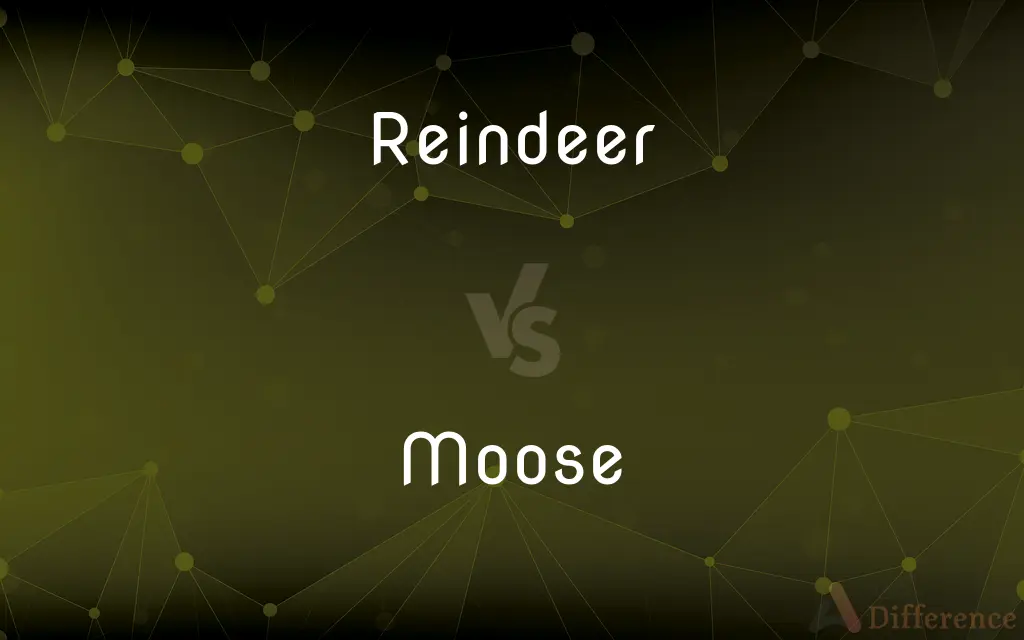Reindeer vs. Moose — What's the Difference?
By Tayyaba Rehman & Fiza Rafique — Updated on September 8, 2023
Reindeer are smaller, domesticated members of the deer family often associated with the Arctic and tundra, while moose are large, solitary animals found in forests in the Northern Hemisphere.

Difference Between Reindeer and Moose
Table of Contents
ADVERTISEMENT
Key Differences
Reindeer and moose both belong to the deer family, but their size and appearance are significantly different. Reindeer are smaller and are often domesticated, especially in regions like Scandinavia and Siberia. Moose, on the other hand, are one of the largest land mammals in North America and Eurasia and are not domesticated.
Reindeer are well-known for their social behavior and often travel in herds. They are also famous for their annual migrations which can cover great distances. Moose are generally solitary creatures that do not migrate, preferring to live in forested areas where they can find plenty of vegetation to eat.
Another striking difference is the appearance of their antlers. Reindeer antlers are more intricate and are present in both males and females. Moose antlers are large, broad, and palmate and are found only in males. The antlers in each species serve different purposes, from social dominance in reindeer to attracting mates in moose.
In terms of habitat, reindeer are typically found in tundra and Arctic regions, well-adapted to extremely cold environments. Moose are primarily forest dwellers, and they prefer regions with colder climates but with more vegetation and water bodies. They are excellent swimmers, unlike reindeer, who are more adapted to land and snow.
Comparison Chart
Size
Smaller
Larger
ADVERTISEMENT
Social Behavior
Herd-oriented
Solitary
Antlers
Both genders, intricate
Males only, broad and palmate
Habitat
Tundra, Arctic
Forests
Domestication
Often
Never
Compare with Definitions
Reindeer
Reindeer is a domesticated or wild deer found in Arctic regions.
We saw a herd of reindeer crossing the frozen lake.
Moose
Moose is a large, solitary member of the deer family.
A moose was spotted wading in the lake.
Reindeer
Reindeer are well-adapted to extremely cold environments.
The reindeer's hooves provide excellent traction on ice.
Moose
Moose have broad, palmate antlers found only in males.
The male moose displayed impressive antlers.
Reindeer
Reindeer are often associated with folklore and myths.
Children love the story of Santa's flying reindeer.
Moose
Moose are primarily found in forested regions.
We encountered a moose on our forest hike.
Reindeer
Reindeer are known for their annual long-distance migrations.
The reindeer migrate hundreds of miles to find food.
Moose
Moose are native to the Northern Hemisphere.
Moose are commonly found in North America and Eurasia.
Reindeer
Reindeer possess antlers in both males and females.
The female reindeer also had antlers, unlike most deer species.
Moose
Moose are excellent swimmers.
The moose swam across the river effortlessly.
Reindeer
The reindeer (Rangifer tarandus), also known as caribou in North America, is a species of deer with circumpolar distribution, native to Arctic, subarctic, tundra, boreal, and mountainous regions of northern Europe, Siberia, and North America. This includes both sedentary and migratory populations.
Moose
The moose (in North America) or elk (in Eurasia) (Alces alces), is a member of the New World deer subfamily and is the largest and heaviest extant species in the deer family. Most adult male moose have distinctive broad, palmate ("open-hand shaped") antlers; most other members of the deer family have antlers with a dendritic ("twig-like") configuration.
Reindeer
A large deer (Rangifer tarandus) of the Arctic tundra and northern boreal forests, having large hooves and long branched antlers, and widely domesticated in Eurasia. Subspecies native to North America and Greenland are usually called caribou.
Moose
A large deer (Alces alces) of northern North American and Eurasian forests, having a broad pendulous muzzle, humped shoulders, and large, palmate antlers in the male.
Reindeer
(plural: reindeer) Any Arctic and subarctic-dwelling deer of the species Rangifer tarandus, with a number of subspecies.
Moose
The largest member of the deer family (Alces americanus, sometimes included in Alces alces), of which the male has very large, palmate antlers.
We saw a moose at the edge of the woods.
Reindeer
Any species, subspecies, ecotype, or other scientific grouping of such animals.
Moose
Any of the extinct moose-like deer of the genera Cervalces and Libralces.
Reindeer
To herd or farm reindeer
Moose
An ugly person.
Reindeer
Any ruminant of the genus Rangifer, of the Deer family, found in the colder parts of both the Eastern and Western hemispheres, and having long irregularly branched antlers, with the brow tines palmate.
Moose
An Asian girl taken as a lover.
Moose
A large cervine mammal (Alces alces syn. Alces machlis, syn Alces Americanus), native of the Northern United States and Canada. The adult male is about as large as a horse, and has very large, palmate antlers. It closely resembles the European elk, and by many Zoologists is considered the same species. See Elk.
Moose
A member of the Progressive Party; a Bull Moose.
Moose
A member of the fraternal organization named Loyal Order of Moose.
Moose
Large northern deer with enormous flattened antlers in the male; called elk in Europe and moose in North America
Common Curiosities
Are reindeer smaller than moose?
Yes, reindeer are generally smaller.
Do reindeer and moose live in the same habitats?
No, reindeer prefer tundra and Arctic regions, while moose prefer forests.
What do reindeer and moose eat?
Both are herbivores, but their diets differ based on their habitats.
Are reindeer domesticated?
Yes, especially in regions like Scandinavia and Siberia.
Are reindeer social animals?
Yes, they often move in herds.
Can moose swim?
Yes, they are excellent swimmers.
What family do reindeer and moose belong to?
Both belong to the deer family.
Do both species have antlers?
Yes, but reindeer antlers are found in both genders, while only male moose have antlers.
Are reindeer found only in cold regions?
Yes, they are adapted to extremely cold climates.
Are reindeer and moose hunted?
Both are hunted but for different reasons: reindeer for herding and moose for sport.
Do reindeer and moose have predators?
Yes, both face predators like wolves.
Do moose migrate like reindeer?
No, moose are generally solitary and do not migrate.
Is it true that only male moose have antlers?
Yes, only male moose have broad, palmate antlers.
Are reindeer involved in folklore?
Yes, they are famously part of the Santa Claus story.
Are moose dangerous to humans?
They can be, especially if provoked or during mating season.
Share Your Discovery

Previous Comparison
Opposite vs. Inverse
Next Comparison
Resolve vs. SolveAuthor Spotlight
Written by
Tayyaba RehmanTayyaba Rehman is a distinguished writer, currently serving as a primary contributor to askdifference.com. As a researcher in semantics and etymology, Tayyaba's passion for the complexity of languages and their distinctions has found a perfect home on the platform. Tayyaba delves into the intricacies of language, distinguishing between commonly confused words and phrases, thereby providing clarity for readers worldwide.
Co-written by
Fiza RafiqueFiza Rafique is a skilled content writer at AskDifference.com, where she meticulously refines and enhances written pieces. Drawing from her vast editorial expertise, Fiza ensures clarity, accuracy, and precision in every article. Passionate about language, she continually seeks to elevate the quality of content for readers worldwide.















































